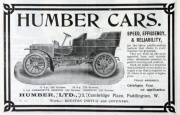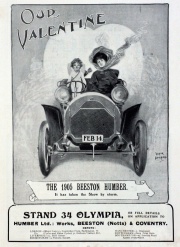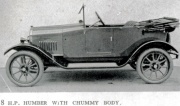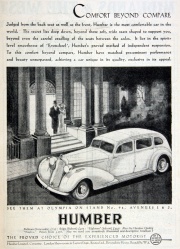Humber: Cars
Note: this is a sub-section of Humber
1896 C. H. Shacklock the manager of the Wolverhampton cycle factory designed a motor car. In 1934 the 'Wolverhampton Express and Star' printed a photo on the car with Shacklock at the wheel, but little else is known.
1897 They exhibited at the 1897 Stanley Cycle Show as Humber and Co (Extension) Ltd with an engine which they announced they were about to build a voiturette of the Bollee pattern, with air cooling.[1]. This followed the purchase on the English manufacturing rights for Bollee by Harry Lawson for £20,000 in 1896.
1898 At the 1898 Stanley Cycle Show they exhibited the Sociable which was the first car produced and was a three-wheeled tricar. Seating in the Sociable was side-by-side as opposed to the Leon Bollee where it was tandem style.
1899 Produced the Phaeton which had a single-cylinder engine and a tubular steel frame. [2]
1900 Produced 3, 3.5 and 5 h.p. Phaeton models.[3]
1901 The first conventional four-wheeled car appeared. This was built under licence from the British Motor Traction Co and powered by a 4.5 h.p. De Dion-Bouton engine.
1901 December. Details and image of the 6-hp light car.[4]
1902 Larger-engined version of 4.5 h.p. model launched with 9.5 h.p. engine.
1902 March. Details of the two-cylinder 9.5-hp car.[5]
1902 Announced they had moved car production from Coventry to new and extensive premises at Beeston (See advert for 1902).
1902 April. Details of the 12-hp Car.[6]
1902 12 h.p. Humber No 66. (See image). Designed by Louis Coatalen it continued in production during 1903.
1902 June. Descriptions of the 8hp and 12hp models.[7][8]
1903 12 h.p. continued and new 20 h.p. model announced in January (see advert). The 20 h.p. was 4.45in. bore x 5.75in. stroke.
1903 A 9 h.p. three-cylinder model. Entered in the 1903 Reliability Trial.
1904 February. Advertised a 8.5 h.p. car(see advert).
1904 Introduced the 5 h.p. Humberette. 500 produced in the first six monthe with 190 from Beeston.
1904 September. Details of the 10-12hp car.[9][10]
1905 February. Details of the Beeston-Humber 8-10 hp and 16-20 hp car.[11]
1905 March. Details of the Coventry Humber 10-hp car.[12]
1905 September. Details of the T.T. car.[13]
1906 Produced 10-12 h.p car under the Coventry-Humber name and 16-20 and 30-40 h.p. models under the Beeston-Humber name. All were shaft-drive with vertical engines. [14]
1906 See Humber: 1906 Coventry Factory
1906 March. Details of their four- and six-cylinder cars.[15][16][17][18][19]
1906 March. Details of the 'Beeston Humber six-cylinder car.[20]
1906 June. Details of the Coventry Humber 10-12hp car.[21]
1907 They produced a car that won the 1907 Tourist Trophy Race. [22]
The company had factories in Beeston, near Nottingham, and Coventry. The Beeston factory produced a more expensive range known as Beeston-Humbers but the factory closed in 1908 after financial problems.
1907 November. Details of their Beeston-Humber cars including the 20-hp and 30-hp.[23][24][25]
1907 November. Details of their Coventry-Humber cars including the 10-hp, 15-hp and 30-hp.[26][27][28]
1908 November. Details of the 8-hp car shown at Olympia.[29]
1909 November. Details of the new models. 8-hp, 12-hp and 16-hp.[30]
1910 October. Details of the latest Humber cars - 8hp, 12-20hp, 16-24hp, 20-28hp.[31]
1911 September. Details of three new models for 1912: 11-hp, 14-hp and 20-hp.[32]
1912 July. Trials of the 11.3-hp car (introduced at end of last year).[33]
1912 November. Details of the four models: 11hp, 14hp, 20hp and 20hp.[34]
Before the First World War a wide range of models were produced from the 600cc Humberette to several 6 cylinder 6 litre models.
1913 Humber was the second largest manufacturer of cars in the United Kingdom.
1913-1917 For a list of the models and prices see the 1917 Red Book
1914 March. Details of the cars for the TT race.[35]
1914 November. Details of the 10-hp, 11-hp and the 14-hp cars.[36]
1925 Humber moved into the production of commercial vehicles with the purchase of Commer at Luton. [37]
1927 Introduced the 20/55 model. Also producing the mainstay of the range the 14/40 and the 9/20 model.
1928 Purchased Hillman, its close neighbour in Coventry.
1930 Main production was the Snipe and the 16/50 models.
1931 16/50, Snipe and Pullman cars produced.
1931/2 Independence ended when the Rootes brothers bought a majority shareholding to become part of the Rootes Group. The range focused on luxury models, such as the Humber Super Snipe, Hawk and Pullman.
WW2 During World War II, several armoured cars were produced under the Humber name. The factory also prodced Bristol aero engines.
In the post-war era, Humber's mainstay products included the four-cylinder Hawk and six-cylinder Super Snipe. Being a choice of businessmen and officialdom alike, Humbers gained a reputation for beautifully-appointed interiors and build quality. Luxury bodies were built by Thrupp and Maberly. [38]
1951 Exhibitor at the 1951 Motor Show in the Car Section.
1954 Advert on this page for the Super Snipe. [39]
1963 Motor Show exhibitor. Showed Super Snipe including estate version, Hawk and Sceptre. Listed as of Coventry and part of Rootes Motors.
1975 Its last car was the Humber Sceptre, an upmarket version of the Hillman Minx. The marque was shelved in 1975, when all Hillmans became badged as Chryslers. The Hillman Hunter was subsequently badged as a Chrysler until production ceased in 1979 when Chrysler's European division was sold to Peugeot and the marque renamed Talbot. The Talbot marque was abandoned on passenger cars at the end of 1986, although it was continued on vans for six years afterwards.
The world's largest collection of Humber cars can be viewed at the Marshalls Post-Vintage Humber Car Museum in Hull. Includes 21 Humber cars dating from 1932-1970 on permanent display, plus 24 unrestored cars. When the Queen Mother visited Western Australia in the 1950's, a Humber was shipped over for her. It was left in a paddock, and was rediscovered and verified in 2002. It has since been restored and is currently privately owned.
Early Registration Numbers
List of Models pre-WWI
- Humber: Sociable 1898
- Humber: Phaeton 1899-1900
- Humber: M.D. Voiturette 1900
1901
- Humber: 4.5 h.p. 1901
1902
- Humber: 8 h.p. 1902
- Humber: 9.5 h.p. 1902
- Humber: 12 h.p. 1902-03 Beeston-Humber
1903
- Humber: Humberette
- Humber: 9 h.p.
- Humber: 12 h.p. (1903)
- Humber: 20 h.p. Beeston-Humber
- Humber: Olympia c1904
1904
- Humber: 8.5 h.p. 1904
- Humber: 14 h.p. 1904
- Humber: 25 h.p. 1904
1905
- Humber: 8-10 h.p. 1904-05 Coventry-Humber
- Humber: 10-12 h.p. 1904-06 Coventry-Humber
- Humber: 12-14 h.p. 1905
- Humber: 20-25 h.p 1905
- Humber: 20-30 h.p. 1906 Beeston-Humber
- Humber: 30-40 h.p. 1906 Beeston-Humber
1906
- Humber: 10-12 h.p. (1906) Coventry-Humber
- Humber: 16-20 h.p. (1906) Beeston-Humber
1907
- Humber: 10-12 h.p. (1907) Coventry-Humber
- Humber: 15 h.p. (1907) Coventry-Humber
- Humber: 30 h.p. (1907) Beeston-Humber.
1908
- Humber: 10-12 h.p. (1908) Coventry
- Humber: 15 h.p. (1908) Coventry
- Humber: 20 h.p. (1908) Beeston
- Humber: 30 h.p. (1908) Coventry
- Humber: 30 h.p. (1908) Beeston
1909
- Humber: 8 h.p. (1909)
- Humber: 12 h.p. (1909)
- Humber: 16 h.p. (1909)
- Humber: 20 h.p. (1909)
- Humber: 30 h.p. (1909)
1910
1911
- Humber: 10-14 h.p. (1911)
- Humber: 12-20 h.p. (1911)
- Humber: 16-24 h.p. (1911)
- Humber: 28 h.p. (1911)
1912
- Humber: 11 h.p. (1912)
- Humber: 14 h.p. (1912)
- Humber: 12-20 h.p. (1912)
- Humber: 20 h.p. (1912)
- Humber: 28 h.p. (1912)
1913
- Humber: 11 h.p. (1913)
- Humber: 14 h.p. (1913)
- Humber: 20 h.p. (1913)
- Humber: 28 h.p. (1913)
- Humber: Humberette (1913) 1913-15
1914
List of Models pre-WWII
- Humber: 15.9 h.p. (1920)
- Humber: 11.4 h.p. (1922)
- Humber: 8 h.p. (1923)
- Humber: 8-18 h.p. (1925)
- Humber: 12-25 h.p. (1925)
- Humber: 15-40 h.p. (1925) 1925-28
- Humber: 9-20 h.p. (1926) 1926-28
- Humber: 14-40 h.p. (1927) 1927-29
- Humber: 20-55 h.p. (1928) 1926-28
- Humber: 9-28 h.p. (1929) 1929-30
- Humber: 16-50 h.p. (1929) 1929-32
- Humber: 20-65 h.p. (1929) 1929
- Humber: Snipe 1930-47
- Humber: Pullman and Imperial Saloon 1930-67
- Humber: 12 h.p. (1933) 1933-37
- Humber: Vogue
- Humber: 16 1936-40
List of Models post-WWII
- Humber: Hawk 1945-67
- Humber: Super Snipe 1945-67
- Humber: Sceptre 1961
- Humber: Pullman
- Humber: Imperial
See Also
Sources of Information
- ↑ Vital to the Life of the Nation. Published 1946.
- ↑ British Motor Cars 1950/51
- ↑ The Humber Story by Demaus and Tarring. Published 1989. ISBN 0-86299-596-5
- ↑ The Autocar 1901/12/14
- ↑ The Autocar 1902/03/15
- ↑ The Autocar 1902/04/12
- ↑ Automotor Journal 1902/06/14
- ↑ Automotor Journal 1902/06/21
- ↑ The Autocar 1904/09/03
- ↑ The Autocar 1904/09/12
- ↑ The Autocar 1905/02/11
- ↑ The Autocar 1905/03/25
- ↑ The Autocar 1905/09/09
- ↑ The Automobile Vol. III. Edited by Paul N. Hasluck and published by Cassell in 1906.
- ↑ Automotor Journal 1906/03/24
- ↑ Automotor Journal 1906/03/31
- ↑ Automotor Journal 1906/04/07
- ↑ Automotor Journal 1906/04/14
- ↑ Automotor Journal 1906/04/21
- ↑ The Autocar 1906/03/24
- ↑ The Autocar 1906/06/09
- ↑ British Motor Cars 1950/51
- ↑ Automotor Journal 1907/11/09
- ↑ Automotor Journal 1907/11/16
- ↑ Automotor Journal 1907/11/30
- ↑ Automotor Journal 1907/11/09
- ↑ Automotor Journal 1907/11/16
- ↑ Automotor Journal 1907/11/30
- ↑ Automotor Journal 1908/11/14
- ↑ The Autocar 1909/11/06
- ↑ The Autocar 1910/10/22
- ↑ The Autocar 1911/09/30
- ↑ The Autocar 1912/07/13
- ↑ The Autocar 1912/11/02
- ↑ The Autocar 1914/03/21
- ↑ The Autocar 1914/11/14
- ↑ British Motor Cars 1950/51
- ↑ British Motor Cars 1950/51
- ↑ [1] History World







































































